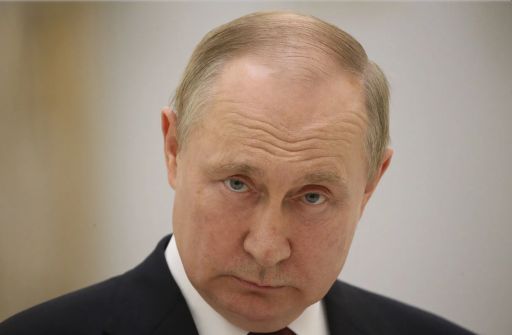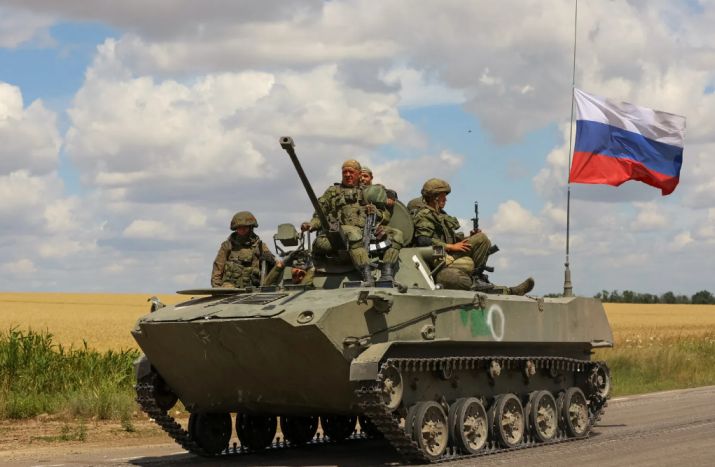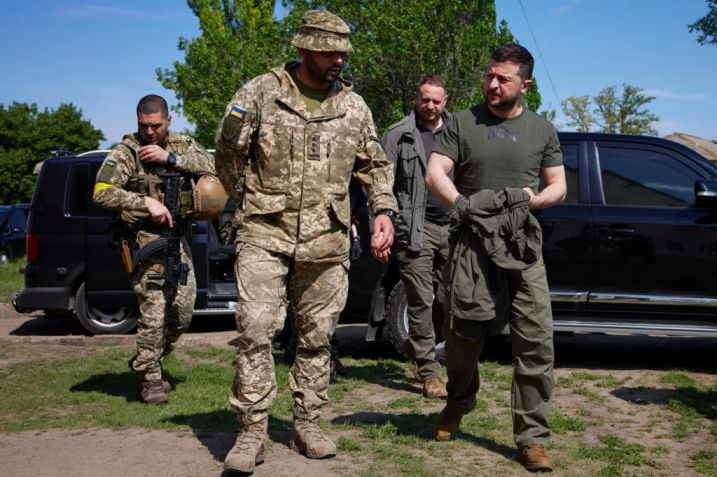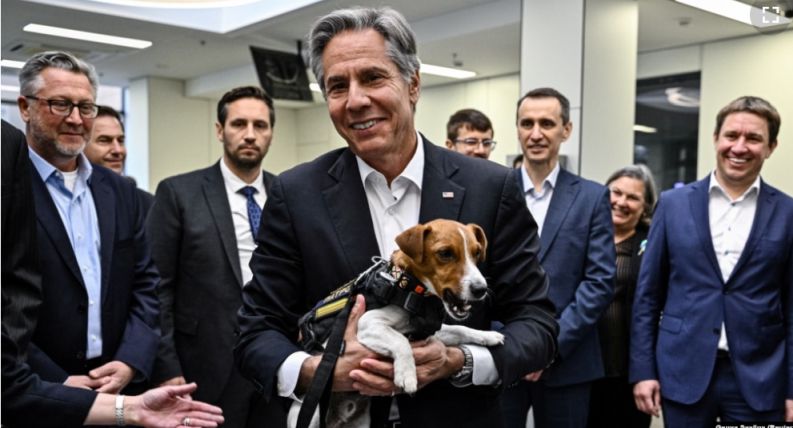By Eric Vandenbroeck and co-workers
Can Ukrainians fight back to the
Sea?
As we have seen yesterday for the first time in the war
in Ukraine, Russian President Vladimir Putin must contend with the serious
prospect of losing it. Early setbacks around Kyiv and Chernigov had been
balanced by Russian gains in the south and the east; they could be justified as
tactical retreats and thus as Russian choices, regardless of whether they truly
were. By contrast, the near rout of Russian soldiers in the Kharkiv region on
September 10—and the rapid reconquest by Ukrainian forces of territory spanning
some 2,000 square miles in the east and south—clearly showed that Ukraine was
on top and that Russian troops may continue to fall to future such offensives.
Ukraine’s Kharkiv offensive destroyed the illusion of Russian invincibility. It
has also heralded a new stage in the West’s expectations. Suddenly, Western
leaders and strategists have been able to contemplate Ukraine gaining the upper
hand in this war. This shift in perspective seems certain to unleash a new
dynamic of military support for Ukraine. The argument that Ukraine should sue
for peace, rather than keep fighting, has been refuted.
But the perspective
has changed most dramatically for Russia, and this entails significant new
risks for both Ukraine and the West. Since the failure of his lightning strike
to take Kyiv in February 2022, Putin has been keeping two balls in
the air. One is sustaining the war for the long term with a peacetime Russian
army, having surmised that Ukraine’s military is weaker and that a prolonged
war favors Russia. The other ball is ensuring that Russian society remains
insulated from the war, on the assumption that Putin can maintain high levels
of domestic support as long as ordinary Russians are not exposed to the war’s
costs. Ukraine’s battlefield successes around Kharkiv, however, have
dramatically upset these calculations.

Putin (who
believes Ukraine was given to Russia) is
now confronted with a set of harsh choices. He can keep Russia’s military
commitment limited, maintaining current troop levels and continuing to insulate
Russian society, or he can order a mass mobilization. Either option poses a
serious threat to Putin’s legitimacy. In choosing the former, Putin would give
up the prospect of Russian victory and run the risk of outright defeat.
Already, the nationalist pro-war forces he has released have become more and
more dissatisfied with the conduct of the war. They had been promised land and
glory in a rapid campaign. Instead, they have received a staggering death toll
for minor territorial advances, which now look increasingly precarious.
Continuing the status quo could create dangerous new fissures in Putin’s
regime.
Mobilization, on the
other hand, would radically upset the Kremlin’s careful management of the war at
home. Dramatically increasing Russia’s manpower might seem a logical choice for
a country with a population that is three times the size of Ukraine’s, but the
war’s popularity has depended on it being far away. Even the Russian
terminology for the war, the “special military operation,” has been a hedge, an
obfuscation. Despite the Kremlin’s rhetoric of “denazification,” for the
Russian population, the Ukraine war is entirely unlike the direct,
existential struggle that Russia endured in World War II. By announcing a
mobilization, the Kremlin would risk domestic opposition to a war that
most Russians are unprepared to fight.

Of course, Putin may
choose neither of these options. He may seek to change the war by finding a
middle way between full mobilization and continuing the status quo. Though he
is a self-styled man of action, Putin tends to be indecisive when the stakes
are high, preferring to step into situations without ever resolving them. In
2014, after the annexation of Crimea, Russia moved into eastern Ukraine,
signed a diplomatic agreement, and then dithered for years, neither advancing
nor retreating. In Syria, Russia made its move in 2015, backing up Bashar
al-Assad militarily and turning the tide in his favor. But Syria remains up in
the air, with a political solution to the war entirely out of sight.
Putin has damaged his
regime not just by opening his military to setbacks around Kharkiv but by
matching extravagant political aims in Ukraine to meager and inefficiently
marshaled means. In Ukraine, any of the options now confronting Putin will
have significant consequences. Whatever his next move, Europe and the United
States should continue supplying the Ukrainian army with the tools it needs
most to stay on the offensive. But they must also consider more far-reaching
implications for a regime that might be facing growing pressure at home while
it seeks new ways to inflict maximum pain on Ukraine and its allies. For
Putin, desperate times will not call for reasoned measures.
An imperial call to battle
It is a quasi imperial war including;
Who controls the past? Blaming the Bolsheviks, conjuring Nazis, divide and
conquer, delusions of grandeur.
Furthermore a decision
by Putin to mobilize the Russian population, to institute a
draft and to call hundreds of thousands of new soldiers, would raise stark new
challenges for both Russia and the West. Even if only partial, a
Kremlin-ordered mobilization would amount to a full recognition that the
country is at war. It would also make that war existential for Russia. Until
now, the invasion of Ukraine has not even been presented as a war to most
of the Russian population. It has been termed a military operation,
which has in practice been a war of choice built on delusional overconfidence
and false assumptions about Ukraine and about Ukraine’s allies and partners.
With mobilization, however, Russia would be publicly investing itself in a
major war. Choice would be transformed into necessity and the “special
operation” into a war that all Russians would need to fight and win. Such a
decision would probably make a defeat unacceptable for the Russian leadership,
rendering the prospect of a negotiated outcome even more unlikely.
This course would be
risky for Putin. Russia’s military performance to date hardly
suggests that throwing more soldiers into the fight would yield better results
for Moscow. In addition, training soldiers would take time, and Russia would
need to provide a commensurate increase in military equipment. At the same
time, by bringing in many Russians who have no interest in fighting,
mobilization could exacerbate rather than resolve problems of morale for the
Russian army. Above all, whether full or partial, a mobilization does not
necessarily mean victory for Russia. Mobilization would need to be tied to
achievable strategic ends.

In pursuing
mobilization, Putin would have to address these military perils while keeping
on board those militarist and nationalist constituencies that have been
empowered by the war and that would certainly welcome this move. The
military peril is one of timing. In addition to receiving adequate training,
new recruits would need to be integrated into fighting units, which would take
many months—at a time when Russia’s officer corps is tied up at the front and
whose members have already been dying in high numbers. And with each passing
month, as a Putin-ordered mobilization gets underway, arms and assistance will
be pouring into Ukraine and the Ukrainian military will be consolidating its
strength. If Russia tries to wait out the winter and to launch a new offensive
in the spring with fresh forces, it would be against a country that is much
more prepared and battle hardened than it was in February 2022.
For Putin, however,
maintaining broad domestic support during mobilization could prove equally
difficult. From the Kremlin’s perspective, during the first six months of the
war, Putin got his domestic politics right. In the absence of a general
mobilization, the Kremlin’s true believers and Russian nationalists
could still thrill to a war of conquest, to a settling of scores with
the West. As for the many Russians who initially had no animus against Ukraine
and were taken aback by the war, many of them, with the Kremlin’s active
encouragement, could simply ignore what was happening. For them, it was a
special operation that should be left to the specialists. Mobilization,
however, would render it impossible to keep the war out of the daily life of
urban Russians. Having been schooled in disengagement from politics by the
Putin regime, they would now have to be mobilized emotionally. They would have
to accept that their fathers, brothers, and sons could die in battle.
Demanding such a large-scale shift in attitude from the Russian population
could easily backfire for Putin.
Mobilization would
not solve the flawed logic of the war. Doubling down on a strategic mistake
doubles the mistake. Mobilization as such would do nothing to minimize the
essential strategic miscalculation of Putin’s decision to launch the invasion.
It would not reverse the many ways in which the war runs counter to Russian
economic and security interests. In this regard, the political dilemma Putin
faces about mobilization relates directly to the nature of the war.
Historically, Russia has proved a formidable adversary when attacked by outside
forces: both Napoleon and Hitler underestimated the depth and resolve of
Russian forces when they chose to invade Russia. But like the United
States and many other countries, Russia has struggled with wars of choice.
The Russo-Japanese war of 1905—which began when diplomacy over Korea broke down
and which Tsar Nicholas II prolonged for the sake of Russian honor—ended badly
for Moscow. So did the Soviet invasion of Afghanistan in 1979. (And in both
cases, the wars unfolded without the added pressures of mass mobilization.) In
contrast to rallying the public for a war of national
defense, mobilization in the name of an ill-conceived imperial project is
a recipe for domestic political unrest. It is better to have a foolish small
war than a foolish big war.
Antony Blinken during
a surprise visit to Kyiv on 8 September where he holds a mine-detection
dog during a visit to the children's hospital:

For Ukraine and the
West, a Russian mobilization would be a psychological shock at first. The
weaknesses of the Russian army will continue to benefit Ukraine, but a
mobilization would signal a renewed resolve by the Russian leadership to stave
off defeat at any cost—even the cost of domestic support. If Putin goes all in,
the West will have to once again assess his state of mind and the potential for
major military escalation.
Pulling back and prolonging
Another option
available to Putin is some form of retreat. In choosing this path, he
would have to give up on the prospect of a genuine victory. He could seek to
keep the war going, reducing commitments to the minimum needed to hold the
territory already gained in the east and south. He could return to his 2014
approach to eastern Ukraine—keeping occupied territory under Russian control
but without advances, thereby destabilizing the entire country—but with a much
greater Russian military presence. Giving up on victory, however, would mean
halting offensive operations. Putin would never admit that he was giving up. He
would suggest that the war will escalate later, that his designs on Ukraine
have not changed, that his claim on success will derive from his strategic
patience. He would have to rely on Russians’ desire to go about their lives unperturbed
by a continual state of war. For this, Russia would need to maintain enough of
a stalemate in eastern Ukraine for Russians to go on ignoring the war.
That may or may not be achievable given Ukraine’s recent gains. Going forward,
Kyiv will do everything it can not to furnish Russia with a politically
convenient stalemate.
For Putin, faced with
dramatic Russian military setbacks, it would be no easy task to sell military
inaction to the Russian public. Until now, the Kremlin has relied on the myth
of his army’s invincibility and the narrative of a defensive war to fuel
support for the “special operation.” Over time, however, a stalled venture,
much reduced in ambition, might expose the futility of a war that has already
resulted in an estimated 70,000 to 80,000 Russian dead and wounded. Even if the
current figure is not widely known in Russia, more and more families will be
affected by the war. Such a venture would also leave Russia’s military and
security apparatus increasingly under attack for their failure to deliver the
promised victory. Some of their members would be thirsting for another
chance—perhaps with another leader.
At the same time, in
seeking to maintain a stalemate, Putin will have to reckon with Ukrainian
forces that are not standing still. Ukraine’s prowess will continue to grow
with more and better weapon deliveries. Under Zelensky’s leadership,
Ukrainians want to win this war. Any serious miscalculation by Russia
could lead to another devastating defeat, which might be definitive. Ukraine
has every incentive not to allow Russia to dig in, though the slow progress of
Ukraine’s counteroffensive around Kherson shows that not every offensive move
of Ukraine’s will necessarily be as successful as the recent one around
Kharkiv.
Dirtier and more dangerous
Given the domestic
risks associated with both mobilization and retreat, Putin may well try to find
a middle way. For Ukraine and the West, this option would be less dangerous
than a full mobilization but still a serious challenge in the next months and
years. Searching for new ways to prosecute the war without the risks of
mobilization, Putin could have several courses of action. He might try to
muddle through with covert mobilization—forcibly recruiting volunteers,
conscripts, and Wagner mercenaries, such as prisoners from Russian
penal colonies. He might unleash new acts of terror against the Ukrainian
population, for example by hitting critical infrastructure, such as energy and
water supplies, to break the will of the population as winter approaches. He
might also increase attacks on essential civilian targets, such as hospitals
and schools, and resort to uglier attacks, such as thermobaric weapons, which
have a devastating effect on their surroundings. In short, he can try to repeat
the extreme tactics that he used in Syria. At the same time, to shore up
his support, Putin might find new ways to repress dissent and prosecute
“traitors” at home.
Choosing this middle
way would be typical of Putin’s indecisiveness in tense situations. Instead of
an announced mobilization, he can use modest new resources to achieve small
successes against Ukraine in areas where Russia’s position is strongest. He can
also wreak havoc in parts of Ukraine that are not directly exposed to fighting,
by attacking critical infrastructure, disrupting any sense of normality across
Ukraine, and doing what he can to block U.S. and European efforts to assist in
reconstruction. In doing so, Putin would attempt to preserve the atmosphere of
danger that has haunted Ukraine since February 2022. If he has trouble
controlling the narrative at home, since this was once a war that Russia was
supposed to win easily, he can use force to crush dissent. For this, his
government is well equipped.
This middle way will
require resolve and patience from the West. Putin will bet on dwindling support
for Ukraine from Europe and the West as they struggle with an energy crisis
throughout at least the coming winter. An increasingly brutal war in Ukraine
could lead to more calls to end hostilities regardless of the conditions
imposed on Ukraine. Even if European countries do not pressure Kyiv explicitly,
they might limit the military support with the argument that their own stocks
and economic capabilities are overstretched. Ukraine’s successes in the Kharkiv
region will postpone this kind of war fatigue for a while. But it is unclear
whether Ukraine can repeat its success and the morale boost that it gave to its
own population and Western audiences.
Western patience, a Russian precipice
For both Ukraine and
its Western allies, it would be preferable for Russia not to mobilize. A better
outcome is for Putin to give up on the prospect of victory. But the means for
influencing Putin’s choices are limited. One is to maintain the status quo, in
which the provision of weapons and intelligence have helped the Ukrainian
military prosper. Ukrainians have already proved that their political system is
durable enough to sustain the war effort. They have already proved that they
have excellent fighting ability and capable military leadership. The coupling
of these internal strengths with the sophisticated weaponry the West is
increasingly prepared to supply intimidated Russian soldiers around Kharkiv.
Whether it has also intimidated the Kremlin is anyone’s guess, but the Kremlin
can only ignore Ukraine’s growing military strength for so long. The greater
this strength, the less Russia can accomplish in Ukraine. Day by day, Ukraine
is acquiring deterrent power.
Given this emerging
reality, the West can hope that Putin might internalize the logic of Russia’s
limits and of Ukraine’s capacities. In the best case, Putin would accept
the tactical and strategic setbacks that began in early September not
in apocalyptic terms but as the outcome of military choices that will define
the scope and aims of eventual negotiations. Ukraine has significantly improved
its negotiation position in recent days and weeks. Russia has not yet
acknowledged the changed balance of power and has not yet toned down its
demands, but it might benefit from doing so in the future, when confronted with
the war’s rapidly diminishing returns. Were Putin to give up on victory by
giving up on offensive operations, even if—as is likely—he refuses to
negotiate, it would be a partial victory for Ukraine and a partial victory for
the West. As such it might seem unsatisfying. Relative to where Ukraine was on
February 24, 2022, however, it would be a superb outcome.
If Russia does
mobilize, Ukraine and the West would best stay
calm. Because Putin’s Russia has been unable to develop a clear
concept for its war, unable to learn from its mistakes, and unable to execute
many of the functions of a world-class military. Mobilization per se would
change none of this. The greatest dangers of mobilization might well relate to
Russia more than to Ukraine. Russians might resist mobilization, in which case
the regime would start to crumble, as the tsarist government did in 1917. Or
Russia might well be defeated after a full mobilization, a debacle Putin would
not survive. Beyond the Kremlin walls, this might sound like a happy ending,
but a collapsed Russia would also upend the international system as we know it
and lead to instability well beyond its borders. Nobody can predict what kind
of regime might follow the collapse of a Putinist
state in Russia.
As they wait for
Putin’s response to Ukraine’s successes, whatever it will be, needs to stay in
the fight and, most of all, to remain on the offensive. At the same time,
despite its awkwardness, Germany and France can use telephone diplomacy to
convey to Putin the futility of his war and his attempts to undermine support
for Ukraine by engineering energy crises in Europe and global hunger crises. If
Putin escalates and resorts to nuclear threats, the West should not be
intimidated.
It should
remind Russia of the invisible rules of the war: that neither side
wants to turn this conventional war into a wider NATO-Russian confrontation. A
nuclear escalation would violate these rules and could lead to NATO
involvement. It would be to everybody’s detriment.
Ukraine’s successes
have opened a solid path to constructing a Ukraine too strong for Russia to
attack in the future. That is a substantial achievement. The unresolved
question is how Putin will attempt to manage Russia’s bleak position, with what
military purpose and with what political message. To give up, he would have to
reinvent himself politically. To mobilize he would have to reinvent the Russia
he has been creating since coming to power in 2000; the Russia saved from the
chaos of the 1990s; the Russia that was ushering in a stable,
consumption-oriented middle class; the Russia in which a private life, far away
from politics, was a pleasant pastime. By invading, Putin thought he would push
Zelensky’s Ukraine into the abyss. He may in fact have done this to his own
regime.
For updates click hompage here